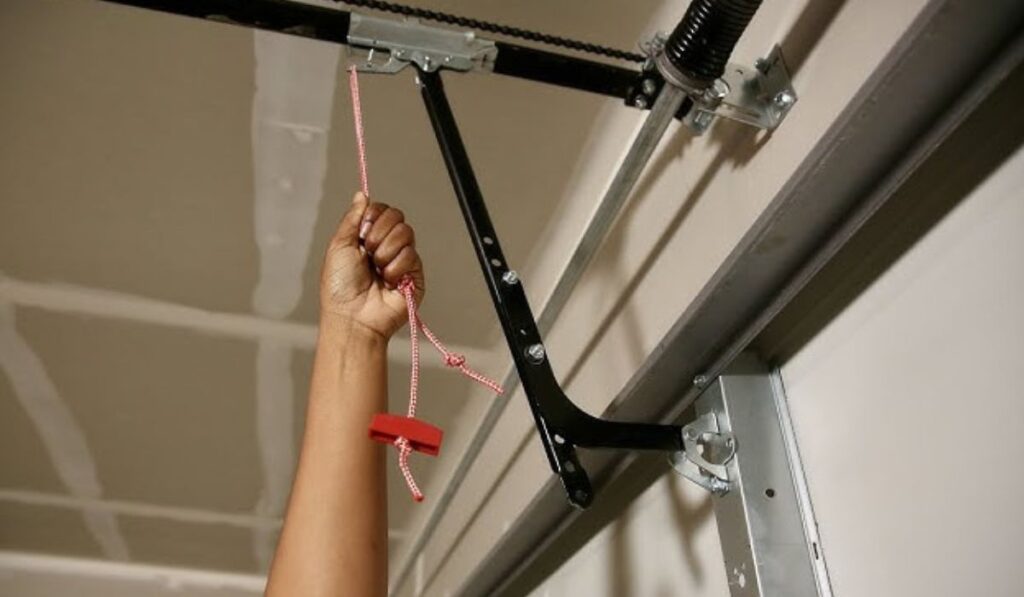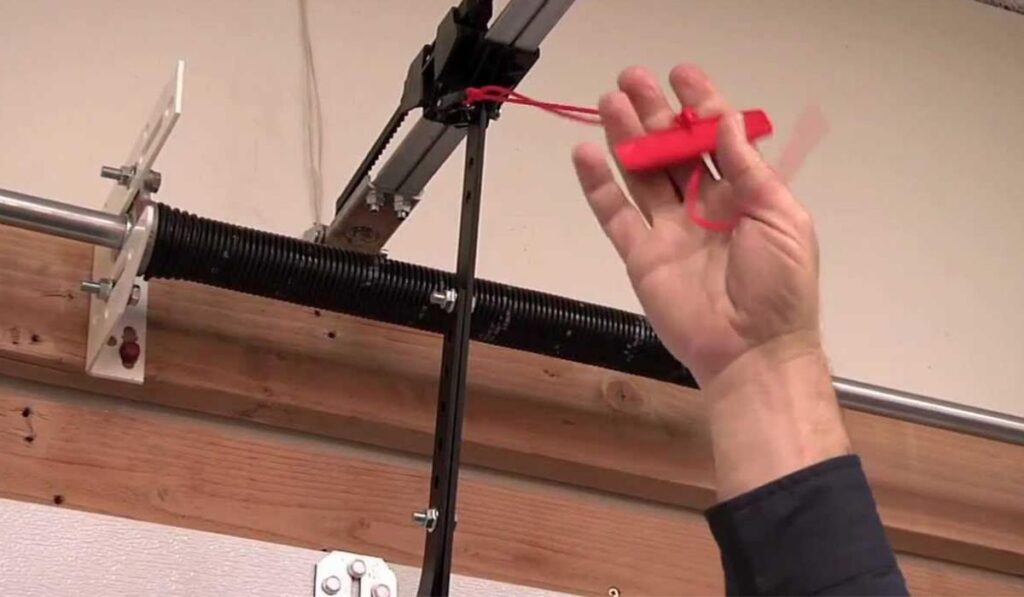
Garage door emergency release red cord is essential for manually opening your garage door during power failures or malfunctions. Knowing how to use the emergency release safely helps prevent accidents and ensures smooth operation, with 24/7 Garage Door Repair offering expert tips on proper use and maintenance.
Regular inspections keep the cord in good condition and ready when needed. If the mechanism feels stuck or damaged, calling a professional right away prevents further issues and costly repairs.
What is the Garage Door Emergency Release?
The garage door emergency release is a safety tool you find on most garage doors. It usually looks like a red emergency release cord or handle. When you pull this cord, it lets you open or close the door by hand if the power goes out or the opener breaks.
This part disconnects the trolley from the garage door opener. So, you can move the door yourself without any power. Here’s what it does:
- The red emergency release cord hangs inside your garage.
- Pulling it moves a small part called the garage door trolley latch.
- This action frees up the garage door emergency pull cord from the opener.
- Once disconnected, you can lift or lower the door manually.
This red emergency release rope is easy to spot and use when you need it most.
How the Emergency Release Works
When you tug on that red emergency release cord, listen for a click sound. That sound means you’ve successfully disengaged the trolley from the garage door opener. The trolley latch unlocks, letting you operate your garage door mechanism by hand.
The garage door trolley sits between your door and opener system. When connected, it pulls your door open and shut automatically. Pulling this emergency release disconnects it so you can control the door yourself. Some quick notes to keep in mind:
- Pull firmly but carefully on the red emergency release rope.
- You should hear a clear click sound once it disengages.
- Before using this, check that nothing blocks your garage door’s path.
- If something seems off with your garage door mechanism, consider reaching out to our emergency garage door repair services for a prompt diagnosis.
Knowing how to safely use your garage door emergency handle can save time during power outages or emergencies. Just remember: if you’re unsure, it’s better to get professional help than risk injury or damage.
Using Emergency Release with a Broken Spring
Using the emergency release red cord on your garage door can be risky. This is especially true if the door has a broken spring or is unbalanced. Garage door springs hold a lot of weight. They help the door open and close smoothly. When a spring breaks, it might snap suddenly. That can cause serious injury.
An unbalanced garage door may fall fast or move unevenly. This makes pulling the emergency release dangerous. Look for signs of broken springs—such as loud noises, difficulty in operation, or visible coil gaps—and schedule a professional garage door spring replacement if necessary. If your door feels heavier on one side or won’t stay open right, that means it might be unbalanced.
Remember: pulling the red cord disconnects the opener from the trolley. But all mechanical parts stay under tension. If your springs are broken or your door isn’t balanced, this tension can cause sudden moves. That could lead to falls or injuries.
For your safety:
- Don’t use the emergency release if you think a spring is broken.
- Avoid pulling it if the garage door moves unevenly.
- Call a pro to check and fix it before you try manual operation.
These steps help stop accidents caused by garage door spring breakage and balance problems.
Pre-Checks Before Pulling the Cord
Before you pull the emergency release red cord, do some quick checks to stay safe:
- Check Door Position: Make sure the garage door is fully closed or nearly closed first. Manually opening a door that’s already open can cause it to move without warning.
- Inspect Springs: Look at both torsion and extension springs closely. Check for damage like gaps in coils or rust. If they look broken, don’t pull the cord—that’s dangerous.
- Look for Obstructions: Clear anything near tracks or rollers that could block the door when it moves manually.
- Test Balance (If Safe): With power off and carefully watching (don’t force anything), see if lifting one side feels as easy as lifting the other side. Equal effort means good balance.
- Confirm No Kids or Pets Are Nearby: Keep everyone away while using manual controls to avoid getting hurt by sudden moves.
These simple checks lower risks from broken parts or stuff blocking your door when you use the emergency release.
Safely Operating the Emergency Release
Your garage door emergency release lets you disconnect the door from its automatic opener. To use it, grab the red emergency release cord and pull it down. This action disengages the trolley, so you can move the door by hand.
When you pull the cord, listen for a click sound—that means it worked. Always think safety first: make sure the door is closed or well supported before you pull. This stops sudden drops and keeps you safe while using your garage door.
Manually Opening Your Garage Door
Opening your garage door manually can be tough because the door is heavy. Here are some tips to keep you safe:
- Make sure nothing blocks the door’s path.
- Stand right in front of the middle of the bottom panel.
- Lift slowly and steadily; don’t rush or jerk it.
- If it feels too heavy, get help with a two-person garage door lift.
- Keep your fingers away from hinges and rollers when lifting.
Moving carefully like this helps stop injuries and makes manual garage door operation easier.
Re-engaging the Trolley
- Check that your garage door is fully closed.
- Find where the red emergency release cord hooks onto the trolley arm on the opener rail.
- Pull down gently on the red cord until you hear a click—that locks it back in place.
- Try your remote control. If it works smoothly, you’re good to go.
If reconnecting feels stuck, look for things blocking tracks or worn parts before trying again. Don’t force it if it won’t connect; call a pro to fix any problems safely.

Troubleshooting and Alternative Methods
The garage door emergency release lets you disconnect the door from the opener so you can open it by hand. But sometimes, problems happen. The cable might break, the opener could stop working right, or parts of the release mechanism might get stuck.
If the cable snaps, the trolley won’t disconnect smoothly. A broken release function can keep the door locked even when you pull the cord. Here are some signs to watch for:
- The red cord feels loose or gets stuck.
- The door doesn’t move when you pull the cord.
- You see worn cables or pulleys near where the release is.
If you see any of these, don’t force the cord! That can cause more damage or make things worse. Instead, call a pro to check it out before anything bad happens.
Testing Your Emergency Release System
You should test your emergency release to make sure it works in a blackout or an emergency. Here’s how to do it right:
- Close your garage door all the way.
- Pull the red release cord slowly to disconnect the trolley.
- Try lifting the door by hand—it should move up easy without any resistance.
- To reconnect, pull down on the handle until you hear a click.
Do this test every few months during a safety check-up for your garage door. Check that cords aren’t frayed, springs feel tight, and pulleys spin freely. Don’t try this if springs are broken or cables look damaged—call a pro to inspect those parts instead.
Alternatives to the Emergency Release Cord
Sometimes, pulling that emergency release cord isn’t safe. This happens if springs are broken or if the door is uneven. If so, try one of these other ways:
Two-Person Garage Door Lift
Have one person hold each side of the bottom edge of the closed door. Then lift slowly together to open it by hand without putting stress on weak parts.
Locking Pliers Method
Clamp locking pliers carefully onto one track rail below where rollers sit in their brackets—never clamp moving parts directly! This holds rollers in place so two people can lift safely without sudden drops.
Both ways take strength and care but can keep things safe when pulling that red cord feels risky because of broken parts.
Maintaining Your Garage Door for Safety
You gotta keep your garage door in good shape. Using a thorough garage door maintenance checklist can prevent unexpected issues and ensure your door continues to operate smoothly and safely. Try a garage door inspection checklist every few months. Check parts like springs, cables, rollers, and the red emergency release cord.
Look closely for damage or wear that can mess up how the door works. Make sure your garage door safety features are working right. This includes sensors that stop the door if something’s in the way. Follow local garage door safety standards so your system fits the rules. Here are some simple repair tips to stop problems:
- Lubricate moving parts often.
- Tighten any loose screws or bolts.
- Test balance by lifting the door halfway; it should stay put.
- Remove stuff blocking tracks or sensors.
If you hear weird noises or see jerky moves when the door works, try some basic troubleshooting first. Check if power is on and sensors line up before calling for help.
When to Call 24/7 Garage Door Repair
Sometimes, you need an expert fast. If springs break, cables snap, or the door won’t stay open, call a garage door repair technician right away. These problems can be dangerous if you fix them wrong.
Getting a professional assessment helps find the real issue fast. A quick garage door service call lowers chances of injury or making damage worse.
Don’t try big repairs yourself unless you know what you’re doing—your safety matters here. Call 24/7 Garage Door Repair for quick help if your emergency release red cord or other key parts act up.
